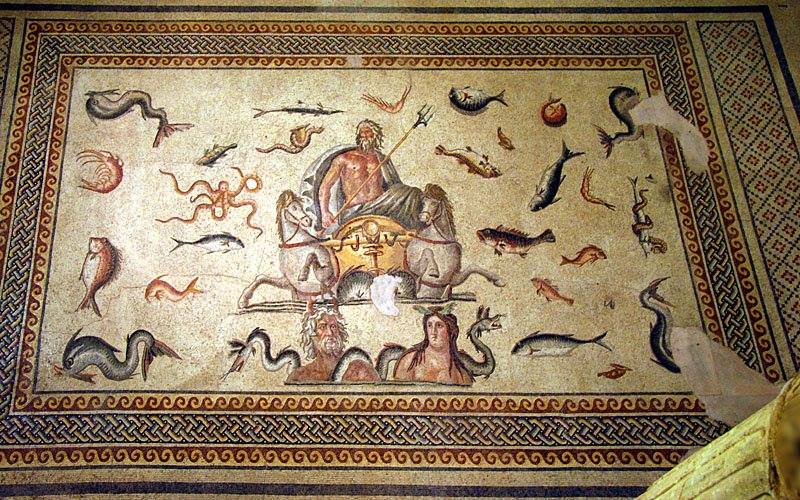Doubtless every reader of the Metamorphoses will come up with his/her own sampling of parts -- themes, motifs, structuring elements, poetic devices, salient features -- that work in concert to produce, if not wholes, at least larger parts.
Below are some that have captured our attention as we've threaded the labyrinth of the poem -- obviously incomplete, overlapping, ongoing:
Below are some that have captured our attention as we've threaded the labyrinth of the poem -- obviously incomplete, overlapping, ongoing:
1. Amor, quest, pursuit, chase, desire, possession, incorporation, motion, seeking. Eros and the stirring of the mind to know, to grasp. Apollo - Daphne, Pan - Syrinx, Atalanta - Hippomenes, Polyphemus - Galatea, Jupiter -> many.
2. Knowledge and Power, saying and doing, word and act, action and understanding, aiming and erring, science and magic. Minos and Daedalus, Ajax and Ulysses, Heracles and Pythagoras, Romulus and Numa, Glaucus and Circe.
3. Nature and Art, Convention and nature, speech and writing, cultivation vs. wildness, symbol and usus. Io, Orpheus, Arachne, Muses, Pierides, Pygmalion, Byblis vs. Iphis.
4. Order and Chaos, Love and War, Marriage and Alliance. Jupiter and Juno, Apollo and Coronis, Mars and Venus, Perseus and Andromeda, Pirithoos and Hippolyta, Minos and Pasiphae.
5. Dreams, visions, prophecies. Ceyx and Alcyone, Morpheus, Myscellus, Aesculapius, Tages and Cipus, Caesar's omens.
6. Paired tales, framed tales. Jupiter and Io, Pan and Syrinx; Philemon and Baucis, Erysichthon; Pomona and Vertumnus, Anaxarete and Iphis; Byblis and Caenis, Iphis and Ianthe.
7. Greece and Rome. Odysseus and Aeneas, Pomona and Anaxarete, Apollo and Aesculapius; Cadmus and Romulus; Phaethon and Augustus, Hippolytus.
8. Structure: Circle, Ring, Linear, Spiral, Rhizome. Cadmus, Theseus, Aeneas, Apollo and Aesculapius, Augustus.
 9. Death and the new: Creation; mutation; magic; nova corpora, mutatas formas, terra nova. Persephone and Hades, Achelous and Perimele, Earth and Serpent, Orpheus, Arethusa, Quirinus, Virbius.
9. Death and the new: Creation; mutation; magic; nova corpora, mutatas formas, terra nova. Persephone and Hades, Achelous and Perimele, Earth and Serpent, Orpheus, Arethusa, Quirinus, Virbius.
10. Ovid as meta-poet. Genres deformed, modes of irony, parody, tropes, modes of myth, epic, history, legend, defamiliarization, wit. The wedding of Perseus, battle of Lapiths and Centaurs, tales of Minyas, Trojan War.
11. Images of speech as system, potentially confusing, echoic world of sound. Gossip, chatter, redundancies, poetics. Fama, Morpheus, Apollo, Corvus and Coronis.
12. Eros and Polis, personal and political, desire and the human order. Io and Juno, Phaethon, Scylla and Minos, Pasiphae and Minos, Acoetes and Pentheus; Medea; Meleager, Atalanta and Althea.
13. Reading: determination and overdetermination, author and mimic; semantic drift, puns, homonyms, enigmas, wonders, and interpretive systems. Etruscan haruspicy, Cephalus and Procris, Corvus and Coronis.
14. Minding the gap: Unspoken relations between seemingly incongruous tales; discontinuity, allegory, irony.
2. Knowledge and Power, saying and doing, word and act, action and understanding, aiming and erring, science and magic. Minos and Daedalus, Ajax and Ulysses, Heracles and Pythagoras, Romulus and Numa, Glaucus and Circe.
3. Nature and Art, Convention and nature, speech and writing, cultivation vs. wildness, symbol and usus. Io, Orpheus, Arachne, Muses, Pierides, Pygmalion, Byblis vs. Iphis.
4. Order and Chaos, Love and War, Marriage and Alliance. Jupiter and Juno, Apollo and Coronis, Mars and Venus, Perseus and Andromeda, Pirithoos and Hippolyta, Minos and Pasiphae.
5. Dreams, visions, prophecies. Ceyx and Alcyone, Morpheus, Myscellus, Aesculapius, Tages and Cipus, Caesar's omens.
 |
| Assassination of Caesar |
6. Paired tales, framed tales. Jupiter and Io, Pan and Syrinx; Philemon and Baucis, Erysichthon; Pomona and Vertumnus, Anaxarete and Iphis; Byblis and Caenis, Iphis and Ianthe.
7. Greece and Rome. Odysseus and Aeneas, Pomona and Anaxarete, Apollo and Aesculapius; Cadmus and Romulus; Phaethon and Augustus, Hippolytus.
8. Structure: Circle, Ring, Linear, Spiral, Rhizome. Cadmus, Theseus, Aeneas, Apollo and Aesculapius, Augustus.
 9. Death and the new: Creation; mutation; magic; nova corpora, mutatas formas, terra nova. Persephone and Hades, Achelous and Perimele, Earth and Serpent, Orpheus, Arethusa, Quirinus, Virbius.
9. Death and the new: Creation; mutation; magic; nova corpora, mutatas formas, terra nova. Persephone and Hades, Achelous and Perimele, Earth and Serpent, Orpheus, Arethusa, Quirinus, Virbius.10. Ovid as meta-poet. Genres deformed, modes of irony, parody, tropes, modes of myth, epic, history, legend, defamiliarization, wit. The wedding of Perseus, battle of Lapiths and Centaurs, tales of Minyas, Trojan War.
11. Images of speech as system, potentially confusing, echoic world of sound. Gossip, chatter, redundancies, poetics. Fama, Morpheus, Apollo, Corvus and Coronis.
12. Eros and Polis, personal and political, desire and the human order. Io and Juno, Phaethon, Scylla and Minos, Pasiphae and Minos, Acoetes and Pentheus; Medea; Meleager, Atalanta and Althea.
13. Reading: determination and overdetermination, author and mimic; semantic drift, puns, homonyms, enigmas, wonders, and interpretive systems. Etruscan haruspicy, Cephalus and Procris, Corvus and Coronis.
14. Minding the gap: Unspoken relations between seemingly incongruous tales; discontinuity, allegory, irony.


No comments:
Post a Comment